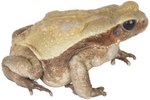
Nearly 4,000 different types of frogs exist, and frogs are found on every continent except Antarctica. They are important indicators of the health of their environments because they're extremely sensitive to changes in air and water quality, to moisture levels and to temperature. Frog populations have been declining markedly. Climate change, chemical pollution, acid rain, roads and loss of habitat are blamed for their disappearance.
Pollution Absorption
Frogs have permeable skin that absorbs toxic materials. These poisons are concentrated and stored in the frogs' fat cells. Frogs spend part of their lives in water as tadpoles. Frogs' soft, jellylike eggs readily take up pollutants when they absorb moisture during development. Pesticides cause thyroid gland problems and physical mutations such as misshapen or extra limbs.
Localized Populations
Frogs live part of their lives in water and part on land. Populations are localized to different habitats. If there are lots of frogs in an area, that indicates a healthy environment. A frog die-off indicates a problem with water, air or soil in their habitat. Frogs in one ecosystem habitat might be thriving while frogs in a different habitat of the same ecosystem are disappearing. Laboratory and field studies let scientists study and compare the causes and effects of environmental changes in localized areas.
Chemical Contamination
Frogs are extremely sensitive to chemical pollution. Tadpoles metabolize chemicals from the water and release them in their urine. The chemicals are then reabsorbed from the same water, much like a human fetus reabsorbs wastes. Scientists study environmental effects on frogs to understand how the environment affects humans. Chemical contamination causes mutations and cancers in frogs.
What Frogs Can Tell Us
As frogs lose their habitats to development, weather changes, logging and pollution, the entire ecosystem is affected. Studies of frogs can tell us when waters are polluted and warn us of how environmental changes affect cell development.
References
- National Geographic Magazine: The Fragile World of Frogs
- Deccan Herald: What Frogs Tell Us About the Planet
- Journey North: Frog
- Michigan Technological University: Frog Watch Activity
- National Geographic Education: Sound the Alarm: Can Frogs Really Tell Us What's Wrong?
- Beyond Pesticides: Wreaking Havok With Life
Photo Credits
-
Stockbyte/Stockbyte/Getty Images
Writer Bio
Karen Mihaylo has been a writer since 2009. She has been a professional dog groomer since 1982 and is certified in canine massage therapy. Mihaylo holds an associate degree in human services from Delaware Technical and Community College.




